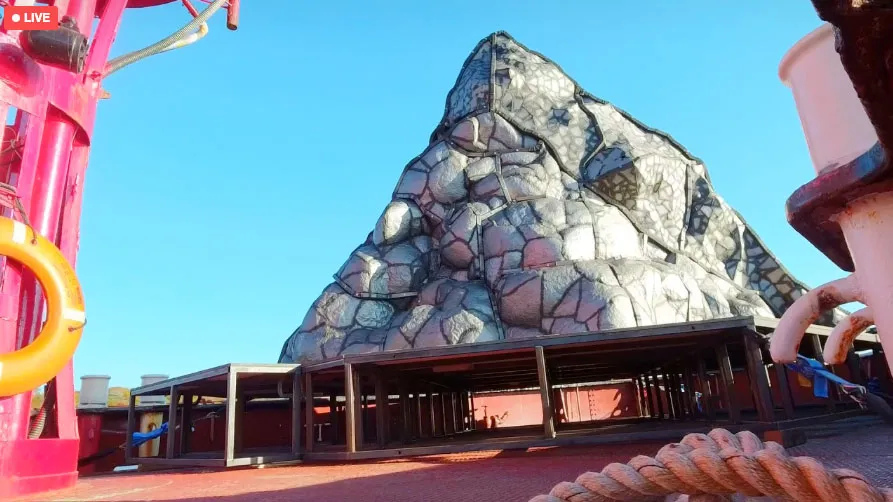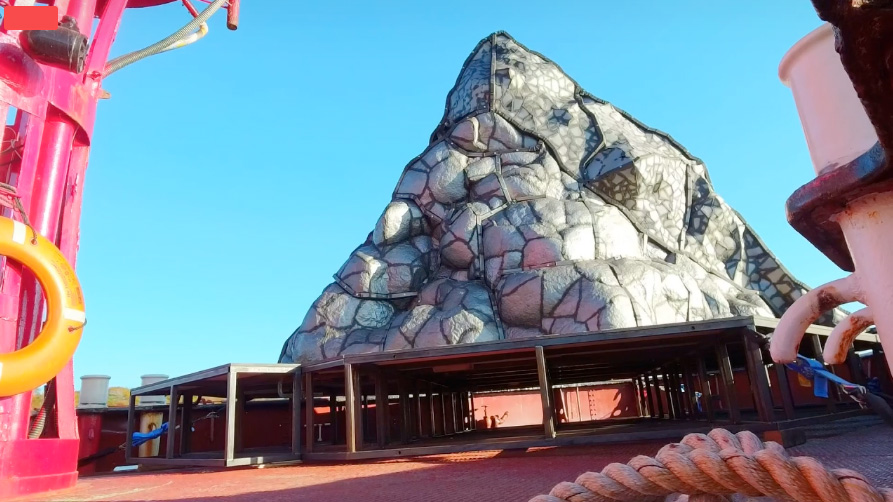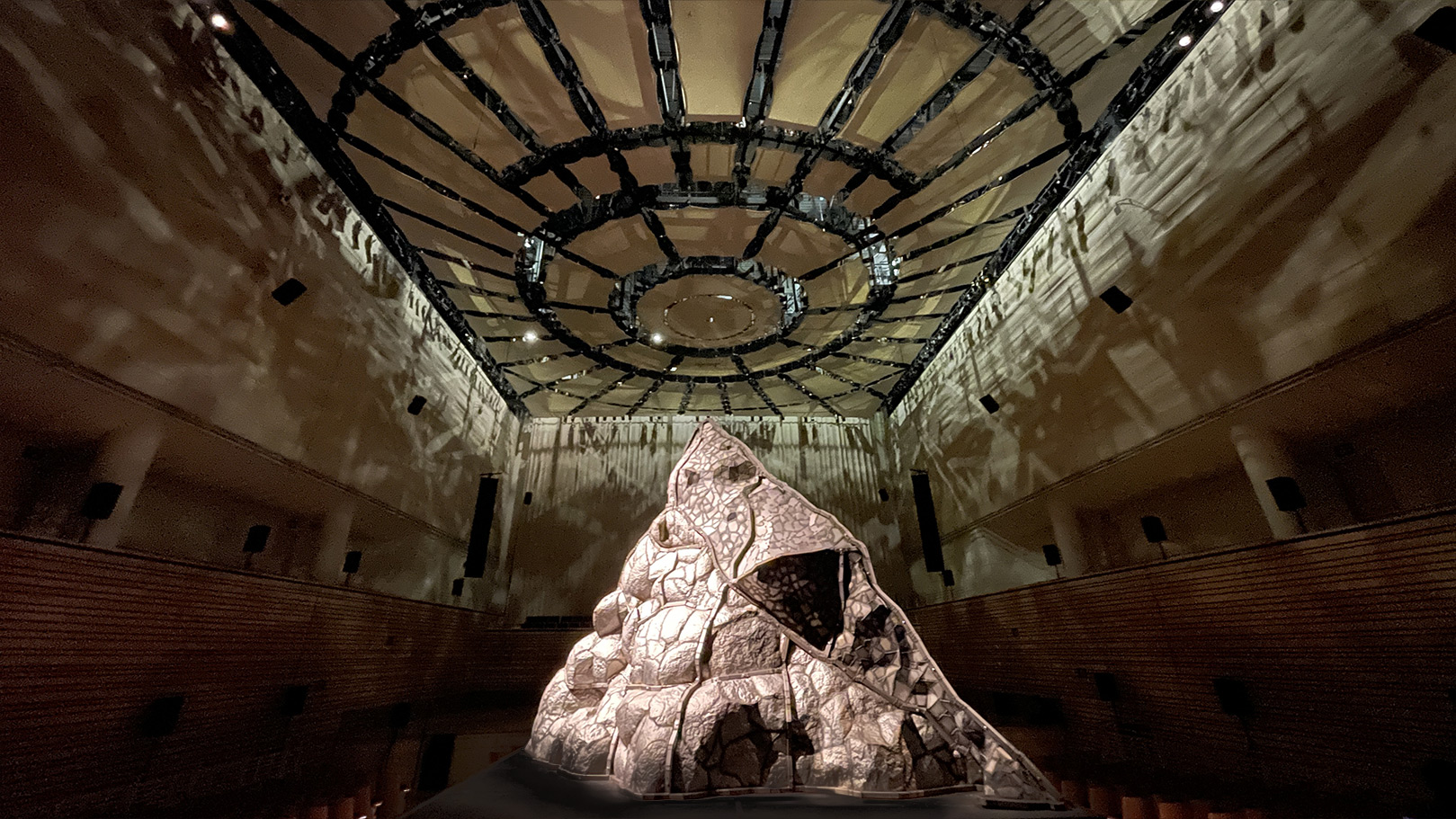
The Volcano that Journeyed up the Hudson River
This weekend, a 12-foot steel volcano will be traveling up the Hudson River on a historic fireboat. Ilopango, the Volcano that Left, a sculpture by artist Beatriz Cortez, departed for Troy on Friday from Storm King Art Center, where it had been installed since May.
The public can view the sculpture at the Hudson River Maritime Museum in Kingston, where the John J. Harvey fireboat will be docked from Friday evening until Sunday morning. Ilopango will also be visible from several points along the shore, and online via live stream, throughout its journey.
Cortez, whose studio is in Los Angeles, welds hammered steel by hand, without a drawing or plan to guide her. The improvisational approach left markings and indentations suggestive of geological features throughout the piece. Cortez aimed to represent the Ilopango volcano, which erupted in the 6th century in what is now El Salvador, her birthplace.
She learned of the cataclysmic event during the pandemic while researching how people coped during previous disease outbreaks. The eruption of Ilopango — among the largest known volcanic eruptions — has been linked to the Justinian Plague of ancient Rome and other far-reaching effects. In the Northern Hemisphere, the sun was darkened for 18 months. Ash dispersed all the way to the Arctic.
In an interview, Cortez likened the volcanic spewing of earth to an upheaval from the underworld. The inframundo (Spanish for “underworld”) is considered a sacred place among ancient and contemporary Indigenous peoples of the Americas, she explained.
“I became fascinated by the idea that the particles of earth from the underworld were spread all over the planet. Indigenous peoples, even contemporary Indigenous peoples migrating right now from Central America to other parts of the world, will be stepping on the sacred particles of their own land,” Cortez said.
Cortez’s work often explores migration “across multiple scales,” said Eric Booker, associate curator of Storm King Art Center, who organized the project. She pushes viewers to rethink not only human migration but also planetary movement and the passage of time, he said.
“Looking at the world through Beatriz’s eyes, you start to see how all of these things are interrelated,” Booker said.
The Atelier Calder in Saché, France awarded Cortez a residency to begin working on the sculpture in 2022. Filmmaker Guillermo Escalón and composer Igor de Gandarias joined her there to record the production process. They’ll continue capturing visual and audio footage from aboard the fireboat and expect to complete a film about the project next year.
“I want the main camera to be the volcano itself,” Escalón said. “The idea is the volcano is like a living creature that has his own view and can listen to the sounds.”
De Gandarias said he plans to record “the sounds of the river,” and the film may also incorporate audio footage of real volcanic activity. He and Escalón have been collaborating for 25 years, including on Symphonies of the Tropics, a multimedia portrayal of the Nahualate River in Guatemala, from 2005. They are currently in residence at EMPAC, the Curtis R. Priem Experimental Media and Performing Arts Center at Rensselaer Polytechnic Institute.
After it completes its journey upriver, Ilopango will be installed in EMPAC’s concert hall as part of the exhibition “Shifting Center” from Nov. 3-18. The “large, reflective, hand-beaten steel surfaces will change the architectural acoustics of the hall,” said Vic Brooks, curator of the exhibition.
The project is presented in partnership with Storm King Art Center, EMPAC–Curtis R. Priem Experimental Media and Performing Arts Center at Rensselaer Polytechnic Institute and the Vera List Center for Art and Politics at The New School.
The project also encompasses an impression in the grass where the sculpture was installed at Storm King. Representing the lasting impacts of people, places and objects after their physical departure, the space will remain empty until Nov. 13.
For Cortez, the “void” evokes migration and movement.
“I’m very interested in the spontaneity of lives of immigrants and lives of matter, (in the idea) that everything is on the move. That spontaneity is represented by that void, because the void continues to enter in conversation,” she said.

Main Image: Still capture of the livestream of Illopango, the Volcano that Left heading up the Hudson River to Troy on Friday, October 27, 2023.

